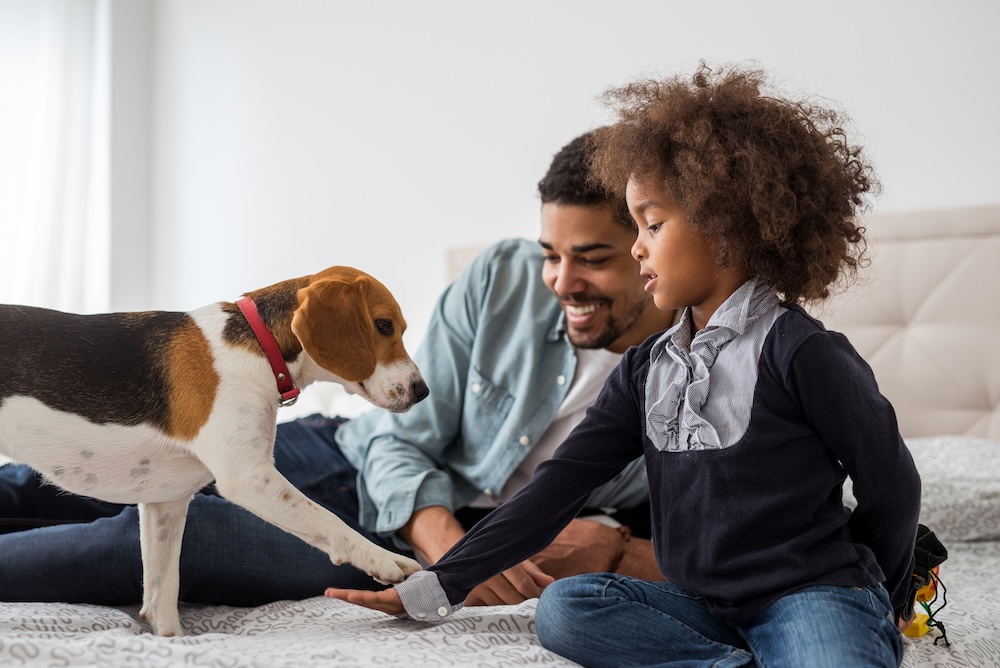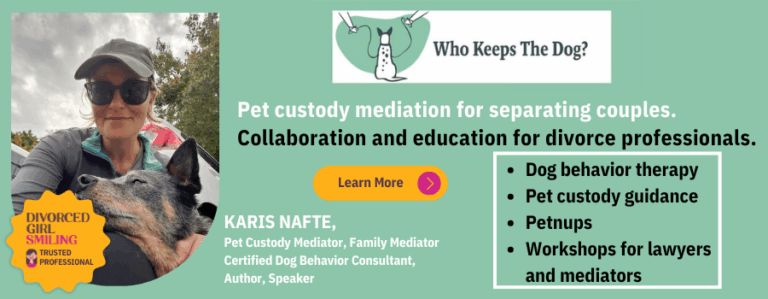Blending families, moving in together and starting a new life seems fairytale like. While it’s a wonderful position to be in, the merging of two families into one can be complex and can often be a challenging process. Adding a furry member to the mix, particularly a dog, can amplify these challenges while also offering a unique opportunity for bonding and shared responsibility.
This article, “A Tail of Two Families: Integrating a Dog into a Newly Blended Family” explores the intricacies of integrating a dog into a newly blended family where there are children in the picture. It highlights the potential pitfalls and offers practical strategies for a successful transition.
Blending families and moving in together
My first piece of advice is, before the newly blended family moves into the same home, give the children and dog the opportunity to spend time together. First impressions carry a lot of weight for a dog, especially if the dog is highly sensitive or anxious.
Let them spend many times together doing the dog’s favorite activity, for example, a walk in the park, a game of frisbee, a road trip to a place the dog loves or simply eating a snack. Ideally, we want the dog to meet the child (or children) when they are in a happy situation so they associate the children with joyful experiences.
Be realistic about what activities the dog and children will be able to do together given the ages of the children and their interest in the dog. The health, temperament and age of the dog, as well as their past experiences with children are equally important.
Kids who love dogs can learn wonderful responsibility from having dog related chores. The benefits of kids doing chores has been well documented ( source from Harvard study ). Give kids age-appropriate jobs to help with the dog. For small children, picking up the dog’s toys, tidying the dog’s bed, or refilling the water bowl can all be fun tasks for them. Older children can play with the dog outside, be in charge of cleaning dog bowls, or grooming, providing the dog is comfortable and happy to be brushed.
In my experience, kids generally fall into one of two categories.; They either naturally love pets and want to be super involved with them, or they are not interested in animals very much. If a child doesn’t really want to be friends with the dog there is no need to force a close relationship especially as everyone in the household is navigating new family dynamics.
Working with dogs and families as a behaviorist for many years, I can tell you that using a dog as a teaching tool for responsibly does not always foster a good relationship with the dog, sometimes it leads to resentment more than anything. If there are new chores being allocated to the children in the household, only give doggy tasks to a child who wants them.
Dogs also tend to follow this pattern, either being inherently fascinated by children, or, preferring the company of adults. If the dogs in the house naturally chooses adult company everyone needs to accept this and not insist that the dog be walked by the children, fed or hugged if this seems to make the dog uneasy in anyway.
In my house, for example, one of my dogs, Sam, is always happy to see my daughter coming home, but he unquestionably prefers my company to her. Sam follows me like a happy shadow and is always interested in what I am doing. He rarely goes into my daughter’s room or cares if she changes her shoes. Whereas my other dog, Bear, spends every moment he can in my daughter’s room and waits patiently for her by the door for an hour or so before she gets home from school. Bear sleeps with my daughter and trots behind her when she moves around the house.
If there are any concerns regarding the dog and children’s interaction visit https://iaabc.org/ to find a qualified dog behavior consultant in your area or contact me at karis@whokeepsthedog.com.
It is crucial that the family all agree on some basic rules for the dog, for family harmony, but more importantly for the dog itself. Different sets of expectations can cause stress and confusion for dogs, so the family must negotiate rules that everyone can live with so the dog can settle into the routine of the house. A common place of conflict is whether a dog is allowed on the furniture.
If one person in the family is happy to have the dog on the couch eating popcorn with them, and someone else doesn’t tolerate dog hair on the sofa, try to find a compromise everyone can live with. In this situation I am a big fan of recommending big snuggle pillows on the floor where the dog can cuddle with the people who want to, meanwhile keeping the dog hair to a minimum for everyone else!
Unless they need to sleep in a crate, I normally recommend allowing a dog to choose where it sleeps, with which person or in what room. Some dogs change rooms regularly depending on their mood, or the temperature. Others will always stick with the same person. If there are multiple young children in the household there might be some jealously between them depending on who the dog sleeps with.
Try to explain to the children that dogs can love everyone even if they don’t choose to sleep in their room. See if there is a compromise that can be made so the other kids feel included in the dog’s life. Perhaps the other kids can have the chance find an activity (with adult supervision) that only they do with the dog, playing with a special toy, learning a new trick or going on a walk.
Remember patience and understanding is important! If the dog is feeling stressed and uncertain during this period, especially if the dog has experienced trauma in the past, offer patience, reassurance, and a consistent routine to help them adapt. If the dog is exhibiting anxiety or fear seek professional help if needed.
Blending families, moving in together and integrating a dog into a newly blended family is a journey that requires careful planning, patience, and a commitment to collaboration. While challenges are inevitable, the potential for strengthening family bonds and creating a loving and shared experience with a furry friend is immense. By embracing communication, compromise, and a shared love for their canine companion, blended families can forge a new chapter filled with unconditional love, shared responsibilities, and the joy of welcoming a new member to their pack.






















good 👍